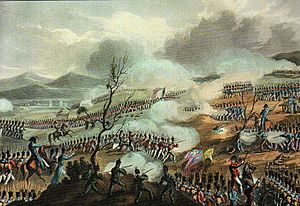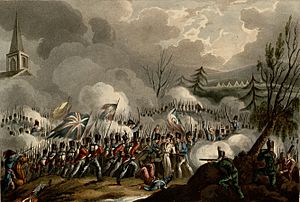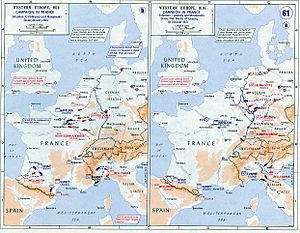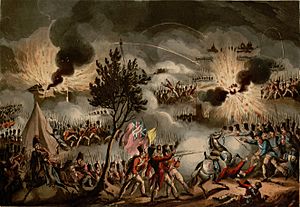Campaign in south-west France (1814) facts for kids
Quick facts for kids Campaign in south-west France |
|||||||
|---|---|---|---|---|---|---|---|
| Part of the Peninsular War | |||||||
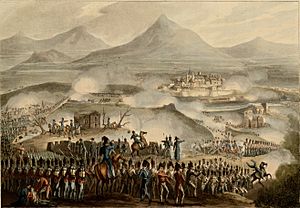 The Battle of Toulouse |
|||||||
|
|||||||
| Belligerents | |||||||
| Commanders and leaders | |||||||
The campaign in south-west France was the last part of the Peninsular War. This war happened in late 1813 and early 1814. An army of soldiers from Britain, Portugal, and Spain fought together. Their leader was Arthur Wellesley, 1st Duke of Wellington. They fought against French forces led by Jean de Dieu Soult. The fighting moved from Spain, over the Pyrenees mountains, and into southwest France. It ended when the Allies captured Toulouse and surrounded Bayonne.
The campaign ended when Napoleon Bonaparte was no longer Emperor of France. A peace agreement, called the Treaty of Fontainebleau, was signed on April 11. The commanders then agreed to stop fighting on April 17, 1814.
End of the War in Spain, 1813–1814
French Counter-Attack in the Pyrenees

In July 1813, French Marshal Soult launched a counter-attack. This was called the Battle of the Pyrenees. He defeated the Allies at the Battle of Maya and the Battle of Roncesvalles on July 25. Soult's army pushed into Spain. By July 27, they were close to Pamplona.
But a large Allied force blocked their way. The Allies were on a high ridge near Sorauren. The French lost their momentum. They were pushed back by the Allies at the Battle of Sorauren on July 28 and 30. The French also lost more men during their retreat into France. This happened at Yanzi (August 1) and Echallar and Ivantelly (August 2). In total, the Allies lost about 7,000 men. The French lost about 10,000.
In August 1813, the British leaders were still worried. Other European powers were fighting Napoleon in the north. The Allies had suffered a big defeat at the Battle of Dresden. They had recovered, but the situation was still uncertain. It was also unclear if Wellington could still count on Spain's help.
Allies Cross into France

On September 8, Wellington accepted the surrender of San Sebastián. This city had been held by French soldiers. Wellington then decided to move his army across the Bidassoa river. This would make his position stronger. It would also secure the port of Fuenterrabia.
At dawn on October 7, 1813, Wellington crossed the Bidassoa. He attacked the French position. The French had two strong lines of defense. These lines stretched from north of Irun to the Great Rhune mountain. The Allies crossed the river near Fuenterrabia. The French were surprised because they thought it was impossible to cross there. The French right side was pushed back. Soult could not send help in time. His defenses fell after tough fighting. He retreated towards the Nivelle river. The Allies lost about 800 men. The French lost 1,600.
On October 31, Pamplona surrendered. Wellington wanted to push Marshal Suchet out of Catalonia. But the British government wanted him to invade France right away. Napoleon had just lost a major battle at Leipzig on October 19. So, Wellington left the fighting in Catalonia to others.
Invading France
Battle of the Nivelle, November 1813
On November 9, 1813, Wellington moved his army forward. Marshal Soult's army had about 79,000 soldiers. They were in three lines of defense. These lines stretched from the sea to the Nivelle river.
Both armies had about 100 cannons. On November 10, Wellington attacked this long French position. His army moved in five groups. After taking the first French defenses, about 50,000 Allied soldiers moved towards the French center. They fought hard and broke through the French lines. This split Soult's army in two. The French right wing fell back to Saint-Jean-de-Luz. The left wing moved towards the Nive river. It was getting late, so the Allies stopped for the night. Soult used this time to retreat to Bayonne. The Allies lost about 2,700 men in the Battle of Nivelle. The French lost 4,000 men, 51 cannons, and all their supplies. The next day, Wellington moved closer to Bayonne.
Battles of the Nive, December 1813
After this, there was a quiet period. The weather was bad, and the Nive river was too deep to cross easily. Wellington also had problems with his Spanish and Portuguese allies. They were not paying or supplying their troops. Spanish soldiers were also causing trouble in France. Wellington sent 25,000 Spanish soldiers back to Spain. He even offered to resign as their commander, but later changed his mind.
Wellington was in a tight spot between the sea and the Nive river. He decided to move part of his army to the other side of the Nive. On December 9, 1813, he crossed the river with some of his forces. These forces were led by Rowland Hill and Beresford. They crossed near Ustaritz and Cambo-les-Bains. Their losses were small. They then moved down the river towards Villefranque. Soult blocked their way to Bayonne. Now, the Allied army was split by the Nive river. Soult, from Bayonne, quickly attacked them. He attacked first on the left bank, then on the right.
On the morning of December 10, Soult attacked with 60,000 men. He attacked Hope, who had 30,000 men. Hope's position stretched from the sea near Biarritz to the Nive. Fierce fighting began. Luckily for the British, the ground was difficult. This forced Soult to advance slowly. In the end, Wellington arrived with Beresford. The French had to retreat.
On December 11 and 12, there were smaller fights. Finally, on December 13, Soult attacked again. He had 35,000 men. He attacked Hill's forces on the right bank of the Nive. Hill had about 14,000 men. They were on some high ground near Saint-Pierre. The fighting at Saint-Pierre was very bloody. But Hill held his ground for hours. He finally pushed back the French. Wellington arrived to help, but his bridge over the Nive had been washed away. In the four days of fighting near Bayonne, the Allies lost about 5,000 men. The French lost about 7,000.
Battle of Garris, February 1814
Fighting started again in February 1814. The French line stretched from Bayonne up the Adour river. Wellington's army was also spread out. His left side watched Bayonne. His right side was near Saint-Jean-Pied-de-Port.
Soult had about 41,000 soldiers ready to fight. Wellington had about the same number, not counting the troops watching Bayonne. Wellington's goal was to draw Soult away from Bayonne. This would allow the Allies to cross the Adour river. Then they could surround Bayonne on both sides.
The Adour river was very wide at its mouth. Crossing it from the sea was dangerous. Wellington decided to try crossing below Bayonne. He gathered many small boats. He left Hope with 30,000 men to watch Bayonne. Then he began to move around Soult's left side. On February 14 and 15, Hill pushed the French posts back. Wellington then pushed these troops back further. Soult left only 10,000 men in Bayonne. He moved his main force to Orthez on the Pau river. Wellington then went to Saint-Jean-de-Luz. He wanted to send boats to the Adour. Bad weather stopped him, so he left this task to others. He returned to the Gave d'Oloron river, crossed it, and faced Soult on the Pau river on February 25.
Crossing the Adour, February 1814
Meanwhile, Hope managed to get 600 men across the Adour river in boats. The French were slow to react. When they did, some new Congreve Rockets confused them. So, the Allies held the right bank. On February 24, a group of boats arrived from Saint-Jean-de-Luz. By noon on February 26, a bridge of 26 boats was built. Batteries and a boom were put in place to protect it. 8,000 troops crossed over. French gunboats were driven up the river. Bayonne was then surrounded on both sides.
Battle of Orthez, February 1814
On February 27, Wellington attacked Soult. This was the Battle of Orthez. Both armies had about 37,000 soldiers. Wellington had 48 cannons, Soult had 40. Soult held a strong position behind Orthez. Beresford was told to try and cut off Soult from Dax. Hill was to move towards the Saint-Sever road. Beresford's attack was pushed back after hard fighting. Wellington saw that the French had left a part of their center open. He sent his Light Division into this gap. At the same time, Hill found a way to cross the river above Orthez. He was moving around the French left side. Soult retreated just in time to avoid being cut off. He withdrew towards Saint-Sever, arriving there on February 28. The Allies lost about 2,000 men. The French lost 4,000 men and 6 cannons.
Action at Tarbes, March 1814
From Saint-Sever, Soult moved east to Aire-sur-l'Adour. This covered the roads to Bordeaux and Toulouse. Beresford, with 12,000 men, was sent to Bordeaux. The city opened its gates to the Allies. Hill pushed Soult from Aire-sur-l'Adour on March 2. Soult then retreated through Vic-en-Bigorre (March 19) and Tarbes (March 20). He finally reached Toulouse, behind the Garonne river. Soult tried to get French farmers to fight the Allies. But Wellington treated them fairly, so they did not rebel.
Wellington wanted to cross the Garonne river above Toulouse. This would let him attack the city from the south, its weakest side. It would also put him between Soult and Suchet. But he found this difficult. So, he left Hill on the west side. He crossed the river at Grenade, below Toulouse, on April 3.
Battle of Toulouse, April 1814
When Beresford rejoined Wellington, the bridge was swept away. This left Beresford isolated on the right bank. But Soult did not attack. The bridge was fixed by April 8. Wellington crossed the Garonne and the Hers-Mort rivers. He attacked Soult on April 10. In the Battle of Toulouse, the French had about 40,000 men and 80 cannons. The Allies had almost 52,000 men and 64 cannons. Soult's position north and east of the city was very strong. It included the Canal du Midi, fortified suburbs, and the high ground of Mont Rave. This hill had strong defenses.
Wellington's troops, led by Beresford, had to march about two miles. They were under fire from cannons and muskets. They were also threatened by cavalry. Then, while Spanish troops attacked the north of the hill, Beresford's men had to turn, climb the eastern slope, and capture the defenses. The Spanish were pushed back. But Beresford's forces took Mont Rave. Soult then fell back behind the canal.
On April 12, Wellington prepared to enter Toulouse from the south. But Soult had retreated during the night of April 11. He moved towards Villefranque. Wellington then entered the city. The Allies lost about 5,000 men. The French lost 3,000. This battle showed the bravery of the Peninsular army.
On April 13, officers arrived with big news. Paris had been captured. Napoleon had given up his power on April 4. This meant the war was practically over. On April 18, Wellington and Soult signed an agreement to stop fighting. This agreement also included Suchet's forces.
Sadly, after Toulouse had fallen, there was another fight. This was a sortie from Bayonne on April 14. Both sides lost about 1,000 men. So, about 10,000 soldiers died after peace had almost been made. The Peace of Paris was officially signed on May 30, 1814.
Aftermath
After the campaign, some British troops went back to England. Others sailed from Bordeaux to America. They were needed for the final months of the American War of 1812. The Portuguese and Spanish soldiers went back over the Pyrenees. The French army spread out across France. Louis XVIII became the new King of France. Napoleon was allowed to live on the island of Elba.


